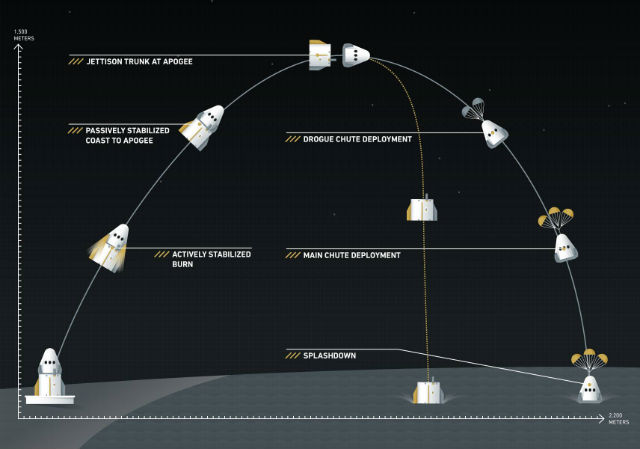US dreams of regaining self-reliance when it comes to launching astronauts to low-Earth orbit from 2017 came a step closer yesterday with the successful test by SpaceX of the launch abort system for its Dragon crew capsule.
The two-minute test from SpaceX’s Cape Canaveral facility saw Dragon – mounted atop a short, dummy first stage “trunk” – fire its abort thrusters to rise along a parabolic path to a height of 1,500m. It then jettisoned the trunk and continued to an Atlantic splashdown, slowed on the descent by drogue and main parachutes (illustrated below).
Further Dragon testing will include a high-altitude abort test and an uncrewed flight to the International Space Station. Boeing’s CST-100 capsule is also being readied for flights under a NASA contract from 2017, and will meet its pad abort challenge in 2016. Since the Space Shuttle fleet was retired in 2011, the US has had to rely on Russian Soyuz flights from Baikonur, Kazakhstan to send crews to the ISS.
Launch abort capability is a critical safety system for crewed missions, providing in effect an ejector seat to pull the capsule away from danger in the event of mishap on the pad or soon after liftoff. As demonstrated by the 1986 Challenger disaster, the absence of such a system was a tragic shortcoming of the Space Shuttle, which rode piggyback on its main rocket – leaving no scope for escape in the event of malfunction.
With Dragon, SpaceX has introduced a potentially significant innovation. Traditional systems like the familiar Apollo configuration – which will also feature on NASA's in-development Space Launch System rocket and Orion crew capsule for deep-space missions – have a tower-mounted abort rocket on the nose of the capsule, which must be jettisoned early in the flight. Dragon’s abort rockets, however, fire through vents at the base of the capsule, as shown in the photograph below – maintaining abort capability all the way to orbit.

SpaceX

Innovative side-venting abort rockets are clearly visible seconds after firing
SpaceX
Source: FlightGlobal.com



















